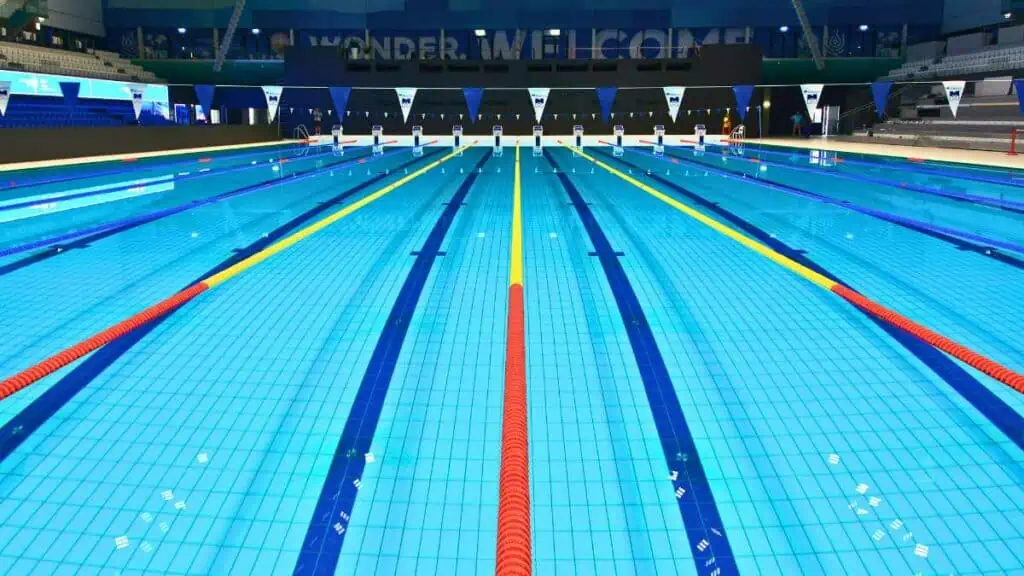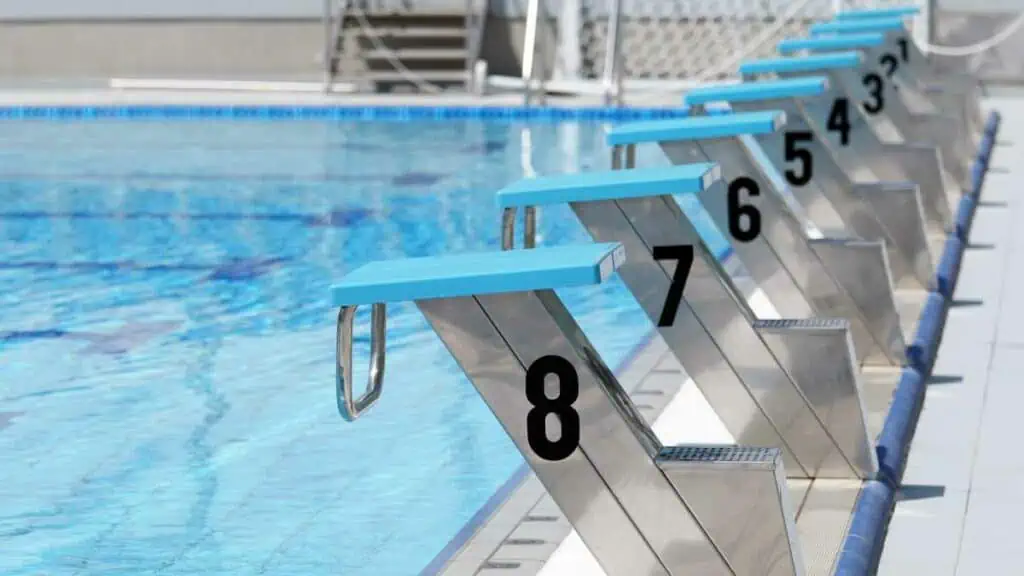Swimming in an Olympic-sized pool is an aspiration for many athletes and enthusiasts. These enormous pools are designed to accommodate high-performance training and competition, conforming to precise dimensions and specifications set by the International Swimming Federation (FINA).
But have you ever wondered how much water is required to fill an Olympic swimming pool?
This post will explore the answer to this question and delve into the fascinating world of pool sizes and capacities. So, let’s jump in and learn more about how many gallons in an Olympic swimming pool!

The Quick Answer: On average, an Olympic size pool can hold approximately 660,000 gallons of water. The standard dimensions for an Olympic pool are 50 meters in length, 25 meters in width, and a depth of at least 2 meters.
How Many Gallons in An Olympic Swimming Pool?
An Olympic-sized swimming pool has a standard length of 50 meters, a width of 25 meters, and a minimum depth of 2 meters.
The volume of water in an Olympic pool is considerably larger than the average backyard pool. Calculating the pool’s volume involves multiplying the length by the width and depth. This gives us:
Pool Volume = Length × Width × Depth
For an Olympic pool, the volume is: 50 m × 25 m × 2 m = 2,500 m³
To convert this volume into gallons and liters, we can use the following conversion factors:
- 1 m³ = 1,000 liters
- 1 m³ = 264.172 gallons (US)
Using these conversion factors, we find that an Olympic pool holds:
- 2,500,000 liters, or
- 660,430 gallons (US) of water
To put that into some form of weird perspective;
Every second, Niagara Falls witnesses a staggering flow of over 3,000 tons of water, equivalent to filling 50 Olympic-sized swimming pools in a mere 60 seconds!
How Does the Volume Compare to The Average Backyard Pool?
Compared to an Olympic-sized pool, an average backyard pool might have dimensions of 12 meters in length, 6 meters in width, and 1.5 meters in depth. Following the same pool calculation method, the volume of this pool would be:
Backyard Pool Volume = 12 m × 6 m × 1.5 m = 108 m³
Converting this to gallons and liters, we get:
- 108,000 liters, or
- 28,528 gallons (US) of water
This means an Olympic swimming pool volume is over 20 times larger than that of an average backyard pool.
How Big Is an Olympic Size Pool?
Olympic swimming pools, or Olympic-sized swimming pools, have specific dimensions and characteristics that set them apart from other swimming pools.
These pools are primarily used for prestigious swimming competitions, such as the Olympic Games, making their shape, size and volume important for standardized racing conditions.
The exact size is mandated in the International Swimming Federation (FINA) specifications in these rules.
How Long Is an Olympic Pool?
The dimensional tolerances of Olympic swimming pools must strictly adhere to the standards set by FINA.
The exact required length of an Olympic pool is 50 meters (164 feet) with the exception below.
For pools with touch panels on both ends, the distance between walls must be a minimum of 50.020 meters and a maximum of 50.030 meters. This means the distance between the touch pads at either end must be 50 meters.
These strict measurements help maintain a consistent experience for swimmers in competitions worldwide.
How Wide Is an Olympic Pool?
An Olympic pool must be 25 meters (82 feet) wide.
The lanes within the pool play an important role in maintaining an optimal swimming environment. An Olympic pool usually has eight lanes, each with a consistent width of 2.5 meters (8.2 feet). Additionally, there must be two spaces with a width of 2.5 meters outside lanes 1 and 8. This creates the equivalent of two empty lanes on either side of the swimming area for improved safety and athlete performance.

How Deep Is An Olympic Pool?
An Olympic pool’s depth is another aspect that is regulated. Olympic swimming pools should have a minimum depth of 2 meters (6.6 feet), though many modern pools are designed to be around 3 meters (9.8 feet) deep.
This minimum depth is required to minimize wave interference and other disturbances from the bottom of the pool, which could affect swimmer performance.
What Temperature Is an Olympic Pool?
Maintaining a comfortable and consistent water temperature in Olympic swimming pools is crucial for the athletes’ performance.
The Federation Internationale de la Natation (FINA) is the regulating body and they specify that the water temperature in Olympic pools (at least during competitions) ranges between 25-28 degrees Celsius (77-82 degrees Fahrenheit).
This optimal temperature ensures swimmers can maintain their body heat while avoiding overheating.
Temperature control in an Olympic-size pool is achieved through various methods, such as heaters and heat pumps. Heaters raise the water temperature by generating heat, while heat pumps transfer heat from the surrounding air into the water.
Additionally, the pool’s circulation and filtration systems help distribute the heat evenly throughout the pool, contributing to a uniform water temperature.
Swimming Regulating Bodies
All World Championships, except for the Masters World Championships and Olympic Games, must be held in swimming pools that comply with the specific FINA regulations. Pool facilities involved in these high-level events are held to the strictest standards to ensure a consistent and fair environment for all athletes.
The International Olympic Committee (IOC) works closely with FINA to ensure that Olympic swimming pools meet all requirements and provide a world-class competitive environment for athletes. These precise standards and regulations ultimately contribute to the integrity and overall success of swimming events during the Olympic Games.





Leave a Reply